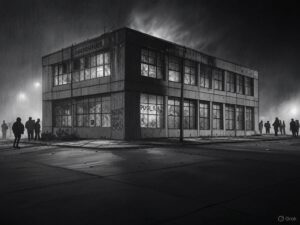⚡ Cutting through noise. Spotlighting the truth.
Far-Left Political Violence in 2025: A Growing Threat

Far-Left Political Violence in 2025: Albuquerque Arson Attack
On March 30, 2025, far-left political violence in 2025 reached a boiling point when a Molotov cocktail shattered the calm in Albuquerque, New Mexico. The Republican Party of New Mexico’s headquarters was set ablaze. Graffiti reading “ICE=KKK” was spray-painted on the walls—a pointed jab at recent ICE raids that arrested 48 illegal immigrants, 20 with criminal convictions, in the area. The Republican Party called it a “deliberate act of domestic terrorism,” and the FBI and ATF have launched an investigation.
This attack is not an isolated incident. It is part of a disturbing trend of far-left political violence in 2025, fueled by ideological rage and America’s deepening political divide. As Trump’s immigration policies inflame tensions, the far left’s response is turning violent. What does this mean for political discourse—and how should the nation respond?
The Context: Immigration Raids and Political Violence
The Albuquerque arson followed ICE raids in early March 2025. These operations targeted illegal immigrants across New Mexico, a state with a strong Democratic lean. Of the 48 arrested, 20 had criminal convictions, including drug trafficking and assault, according to ICE.
The raids, part of Trump’s broader immigration crackdown, sparked protests from progressive groups. They argue the operations tear apart families and disproportionately target minorities.
The graffiti “ICE=KKK” equates U.S. Immigration and Customs Enforcement with the Ku Klux Klan, reflecting a narrative that immigration enforcement is inherently racist. This message resonates in today’s polarized political climate and has fueled far-left anger.
This incident follows a pattern. A 2022 Politico report noted that while far-right extremism accounts for two-thirds of domestic terrorism incidents, far-left violence is on the rise. It is often scattered and fueled by online radicalization. In 2025, that trend continues. Acts like the Albuquerque arson and the recent vandalism of a Tesla in Bucks County, Pennsylvania, show a growing willingness to use violence as a political weapon.
Divided Perspectives on Far-Left Political Violence
The Republican Party of New Mexico, led by Chairwoman Amy Barela, called the arson a “direct assault on our values and a deliberate act of domestic terrorism.”
GOP figures like Rep. Stefani Lord and Sen. Jay Block pointed fingers at Democrats. Specifically, they criticized Rep. Teresa Leger Fernandez, who at a Santa Fe town hall on March 29 urged supporters to “agitate” against GOP policies. Lord labeled Fernandez’s words as “incitement,” arguing they emboldened far-left actors to attack.
On X, users like @DC_Draino echoed these concerns. They labeled the arson as “domestic terrorism” and demanded a federal crackdown.
Fernandez pushed back. She told KOAT, “My call to agitate was about democratic participation—voting, organizing—not violence. The GOP’s accusations are dangerous and divisive.”
Progressive voices on X, like @NMActivist, argue the attack reflects legitimate anger over ICE’s “inhumane” raids, though they stop short of endorsing violence.
This divide reflects a broader tension. The far left views ICE raids as oppressive, while conservatives see violent backlash as an attack on law and order.
For more on political violence, read: Swatting Incident Targets Conservative Star
Far-Left Political Violence in 2025: Data and Cultural Impact
The Albuquerque attack fits a broader pattern of far-left political violence in 2025. The 2022 Politico report highlighted that far-left violence, though less frequent than far-right extremism, increasingly targets political symbols like GOP offices.
In 2025, this trend continues. The Tesla vandalism in Bucks County, Pennsylvania, is another example. The vandal, who later apologized, claimed it was a “misguided expression” of disdain for Musk, a Trump ally. Nonetheless, the swastika’s use underscores the extremism at play.
ICE data from March 2025 reveals the raids in New Mexico were part of a national operation that arrested 680 illegal immigrants—40% with criminal records. This data underscores the scale of Trump’s deportation efforts.
However, a 2024 Pew Research study found that 60% of Americans oppose mass deportations. This cultural divide fuels the far-left backlash. The “ICE=KKK” narrative, though inflammatory, taps into a perception among some that immigration enforcement is racially charged. It’s a misconception the GOP must address with better messaging.
Political Risks of Far-Left Political Violence in 2025
If far-left political violence in 2025 continues unchecked, it risks normalizing such acts and eroding the civility needed for democratic debate. The Albuquerque arson could embolden more attacks, particularly in Democratic strongholds like New Mexico, where GOP organizing already faces challenges.
Economically, this unrest could deter Republican campaign efforts in blue states. Culturally, the “ICE=KKK” narrative deepens mistrust, making compromise on immigration reform nearly impossible.
Solutions begin with accountability. Progressive leaders must unequivocally condemn violence, not merely offer platitudes about “democratic participation.” The GOP, for its part, should focus on winning the narrative war—explaining why ICE raids target criminals, not families. Federal action, as @DC_Draino suggests, may become necessary if violence escalates further. However, both sides must prioritize de-escalation over division.
The Bigger Picture: Far-Left Violence and Democracy
The Albuquerque arson is a wake-up call. Far-left political violence in 2025 is a growing threat, fueled by ideological rage over policies like Trump’s ICE raids. From Molotov cocktails to swastika vandalism, the far left’s tactics are escalating and challenging the norms of political discourse.
We cannot allow this to become the new normal.
Key Takeaways
- Far-left violence is rising, targeting GOP symbols like the Albuquerque headquarters.
- The “ICE=KKK” narrative reflects a cultural divide over immigration enforcement.
- Progressive leaders must condemn violence, not excuse it as “agitation.”
- De-escalation and better messaging are key to restoring civility.
Sources and Further Reading
- Reuters: New Mexico Republican Party HQ set on fire, graffitied ‘ICE=KKK’
- Fox News: Albuquerque GOP headquarters targeted in alleged arson
- Infowars: GOP Headquarters In Albuquerque, NM, Torched In Deliberate Arson Attack
- KOAT: Fire at local GOP headquarters, party blames arson
- Politico: The troubling future of political violence in America
- Pew Research: U.S. Public Opinion on Immigration Policy
- X posts from @DC_Draino and @Lord4NM, March 30, 2025.
Recommended Reads
For more on political violence, check out Politico’s 2022 deep dive into its future in America. The Pew Research study on immigration attitudes offers data on why ICE raids remain divisive. For a local perspective, KOAT’s coverage of the Albuquerque attack includes Fernandez’s rebuttal, adding depth to the debate.




